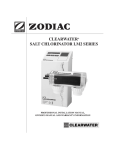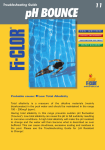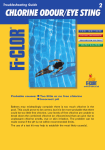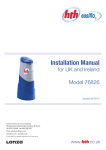Download Troubleshooting Guide
Transcript
9 Troubleshooting Guide www.fi-clor.co.uk Probable cause: ■ Too much chlorine It is not uncommon to find a lack of colour when carrying out the test for free chlorine using a DPD No.1 tablet, when fully expecting to obtain a reading. However, if there are no other indicators such as the presence of algae or cloudy water it is highly likely that there is too much chlorine present. A high level of chlorine will bleach out the dye in the test tablet and give a false indication leading you to believe that there is no chlorine present. When ‘shock’ dosing a pool, care should be taken in calculating the quantity of chlorine required to achieve the desired residual so as to avoid overchlorinating. Greater control of ‘shock’ dosing can be achieved by the use of Fi-Clor Superchlorinator which is supplied in the form of a 350g mini pot and will add approx. 5mg/l (ppm) to (11,000 gallons) 50m3. 9 Troubleshooting Guide W H A T Y O U M A Y N E E D 4Kg Fi-Clor Chlorine/ Bromine Reducer To reduce chlorine level ■ Reduces sanitiser level without the need to discard pool water ■ Rapid dissolving with no residue ■ Fast acting ■ Compatible with all types of filtration equipment Before adding any chemicals to your pool, ensure nobody is swimming A C T I O N T O 1. If you carry out the standard test for free available chlorine and obtain no reading when expecting to find chlorine present, repeat the test following the steps set out below: ■ Make up a solution containing 50% pool water and 50% tap water. ■ Add a few droplets of this solution to the pool tester as normal, not forgetting to first rinse the cell with the solution. ■ Add a DPD No.1 tablet and observe it closely. ■ If a pink colouration can be seen coming from the surface of the tablet, this indicates the presence of chlorine ■ Top up the cell with the solution you have prepared. ■ If this dilution produces a sufficiently stable colour to enable a reading to be taken from the tester, double the reading to give the actual value of the free chlorine. If you notice the colour fading, it is almost certain that the high level of chlorine in the sample is bleaching the reagent in the test tablet. ■ If, after further dilutions you are still unable to obtain a reading or are uncertain about this procedure, take a fresh sample of pool water to your Approved Fi-Clor Dealer who will retest it for you and carry out further dilutions as appropriate. 2.Excess chlorine can be chemically removed using Fi-Clor Chlorine/Bromine Reducer. However, great care should be exercised when using this product as overdosing can lead to an artificial chlorine demand. B E T A K E N ■ If in doubt about the dose rate or procedure, consult your Approved Fi-Clor Dealer. ■ If carrying out this procedure yourself, allow sufficient time for the Fi-Clor Chlorine/Bromine Reducer to fully react with the excess free chlorine. The recommended dose should be applied a little at a time and the free chlorine tested after each application, allowing time for dispersion (1 turnover). NOTE: Chlorine Readings and Bather Safety ■ If the pool is unstabilised and chlorine sanitisers such as calcium hypochlorite or sodium hypochlorite are being used, bathing should not re-commence until the free chlorine level has fallen to 4.0mg/l (ppm) or below. ■ For a fully stabilised pool, bathing may be possible if the chlorine is only a few parts per million above the recommended 4.0mg/l (ppm) maximum. However, caution should be exercised and bathing stopped if any eye or skin discomfort is experienced. The chlorine level should then be allowed to fall of its own accord over a few days. If the chlorine reading is slow to fall, higher than expected or there is a specific need to reduce the chlorine level quickly, Fi-Clor Chlorine/Bromine Reducer may be used in accordance with the above recommendations. Bathers should not use the pool under any circumstances if the free chlorine is above 10mg/l (ppm), irrespective of sanitiser. Further information can be obtained from: Arch Water Products, Wheldon Road, Castleford, West Yorkshire WF10 2JT Tel: 01977 714100 Fax: 01977 714006 www.fi-clor.co.uk 10 Troubleshooting Guide www.fi-clor.co.uk Probable cause: ■ Excess cyanuric acid Cyanuric acid stabiliser is essential in an outdoor pool to reduce chlorine loss by sunlight. However, the level must be kept below an upper limit and if you are using stabilised chlorine products such as Standard Fi-Clor Granules, Premium 5 Granules, Premium 5 Tablets, Maxi or Mini-Tabs, its concentration may well increase, depending on the level of routine water replacement. This condition is sometimes referred to as ‘chlorine lock’ and although a perfectly healthy free chlorine reading can be obtained, the efficiency of the chlorine will be greatly impaired by the high level of cyanuric acid. The symptoms will mimic those of a pool with very little or no chlorine, i.e. cloudy water, algae and there may also be a pungent ‘chlorine-type’ smell. The stabiliser (cyanuric acid) level should be between 30 – 80 mg/l. It should be tested periodically through the season as if allowed to build up unchecked, the problems above will most likely occur. 10 Troubleshooting Guide W H A T 350g Fi-Clor Superchlorinator Y O U M A Y 5Kg Fi-Clor pH Increaser To correct low pH N E E D 7Kg Fi-Clor pH & Alkalinity Reducer For shock chlorination To correct high pH Before adding any chemicals to your pool, ensure nobody is swimming A C T I O N T O 1. To reduce stabiliser (cyanuric acid) level ■ If you suspect a high stabiliser level, carry out a cyanuric acid test. If you are unable to do this, take a sample of pool water to your Approved Fi-Clor Dealer who will test it for you and if necessary, advise how much water you will need to replace with fresh. ■ Due to structural considerations relating to the pool design etc, great care should be exercised when draining large quantities of water and the advice of your dealer should be sought regarding the maximum quantity of water that it is safe to replace in one operation. 2. To control stabiliser (cyanuric acid) level ■ Always ensure there is adequate water replacement when carrying out such routine operations as backwashing the filters. This will reduce the likelihood of needing a major water replacement that would be required to bring the pool back into a useable condition. ■ Never use stabilised chlorine for superchlorination or shock dosing as this will contribute to the problem. The ideal products for this operation are non-stabilised chlorines such as Fi-Clor Superchlorinator or Superfast Shock. These products should be used within the pH range 7.2 – 7.6. To change the pH you will require either Fi-Clor pH Increaser or Fi-Clor pH & Alkalinity Reducer. For instructions on the use of these products please refer to the pack labels or the relevant Troubleshooting Guides. ■ Fi-Clor Superchlorinator is supplied in convenient 350g single-shot packs, which contain sufficient non-stabilised chlorine to treat the average domestic swimming pool of 11,000 gallons (50m3). Strict accuracy is not essential and the contents can be used in pools somewhat larger or smaller than this. ● The pool should be treated during evening hours. Make sure there are no bathers in the water and keep the circulation running, preferably overnight. B E T A K E N ● Broadcast the contents evenly over a wide area in the deepest part of the pool. ● Test the water the following day. Bathing should not recommence until the free chlorine level is 4.0mg/l (ppm) or below. ● To keep the pool water in pristine condition, repeat this procedure once every fortnight. ■ For water that has built up a high level of pollution and algae etc due to excess stabiliser (cyanuric acid) and where a routine superchlorination (as above) is not sufficient, a more severe chlorination with Fi-Clor Superfast Shock will be required. ● Adjust the pH to as near 7.2 as possible. ● Dose Fi-Clor Superfast Shock at the rate of 1.1kg per 11,000 gallons (50m3) i.e. roughly half the container for the average 11,000 gallon domestic pool (accuracy of dosing is not important). ● Broadcast the contents evenly over a wide area in the deepest part of the pool and keep the circulation running. ● Test the water regularly and do not re-commence bathing until the free chlorine level is 4.0mg/l (ppm) or below. WARNING: Do not mix Fi-Clor Superfast Shock with any other types of chlorinating compounds (even other products on the Fi-Clor range) either in the dry state, or in the skimmer. Fire or explosion may result. If using with other products, dose them into the pool separately. ■ If difficulty is experienced in maintaining the cyanuric acid within the recommended range of 30 – 80 mg/l, it would be advisable to change on a temporary basis from a stabilised chlorine to an unstabilised one for routine (daily) treatment, until the cyanuric acid has fallen to manageable levels. Fi-Clor Superfast Granules or Fi-Clor Supercapsules are ideally suited for this purpose. The positive benefits of stabilisation will still be obtained due to the residual cyanuric acid in the pool. When the cyanuric acid level is approaching 30mg/l, stabilised chlorine can be re-introduced as the routine sanitiser. Further information can be obtained from: Arch Water Products, Wheldon Road, Castleford, West Yorkshire WF10 2JT Tel: 01977 714100 Fax: 01977 714006 www.fi-clor.co.uk 11 Troubleshooting Guide www.fi-clor.co.uk Probable cause: ■ Low Total Alkalinity Total alkalinity is a measure of the alkaline materials (mainly bicarbonates) in the pool water and should be maintained in the range 100 – 200mg/l (ppm). Having total alkalinity in this range prevents sudden pH fluctuation (‘bounce’). Low total alkalinity can cause the pH to fall suddenly resulting in corrosive conditions. A high total alkalinity will make the pH resistant to change and the water will then become what is described as over buffered. This can cause cloudiness, excessive scaling and residues in the pool. Please see the Troubleshooting Guide for ‘pH Resistant to Change’. 11 Troubleshooting Guide Low total alkalinity can arise from a number of causes: ■ The make up (fresh mains) water may have a low total alkalinity, usually associated with a ‘soft’ water source. However, in areas where mains water with a low pH and low total alkalinity has been found to be ‘aggressive‘ towards old (lead) pipework systems, the water supply companies have artificially boosted the total alkalinity with chemical additions. It is therefore now unusual to find mains water with an excessively low total alkalinity (& low pH). ■ pH reducing chemicals such as dry acid or hydrochloric acid may have been dosed incorrectly. If these materials are dosed in one spot and not distributed evenly around the pool, an area of high local acidity will be created. The bicarbonates cannot survive in these areas of high acidity (low pH) and some total alkalinity will be destroyed. Please see the Troubleshooting Guide for ‘High pH’ for instructions on dosing pH reducing chemicals. ■ High local acidity can be caused by turning the circulation off when slow dissolving chlorine tablets are being used in the skimmer, pump basket or in a circulatory feeder device. A solution of low pH and relatively high chlorine content will be formed in these stagnant conditions which will have the ability to destroy total alkalinity. TIP: When slow dissolving chemicals such as chlorine tablets are present in the system, the circulation should be kept running continuously whenever possible. W H A T Y O U M A Y N E E D 5Kg Fi-Clor Alkalinity Increaser To raise the total alkalinity Before adding any chemicals to your pool, ensure nobody is swimming A C T I O N To raise the total alkalinity T O ■ To raise the total alkalinity, dose Fi-Clor Alkalinity Increaser at a rate of 1.5kg per 11,000 gallons (50m3). This dose is designed to increase the total alkalinity by approx. 10 – 20mg/l (ppm) and should be repeated as necessary on a daily basis until the total alkalinity is above 100mg/l (ppm). Dose no more than 1kg at a time, dissolving the material in a clean plastic container with 10 litres (approx 2 gallons) of pool water. Always add the chemicals to the water, not vice versa. With the circulation running, distribute the solution around the deep end, avoiding the skimmers. ■ 100mg/l (ppm) is the generally recognised minimum total alkalinity for pools sanitised with stabilised chlorines or bromine. However, for pools sanitised with Fi-Clor Superfast Granules or Supercapsules it may be allowed to fall to 80mg/l (ppm) before corrective action is required. ■ If pH and total alkalinity both need correction, treat the total alkalinity first. ■ If unable to test for total alkalinity, take a fresh sample of pool water to your Approved Fi-Clor Dealer who will carry out the test and advise on any necessary treatment. B E T A K E N ■ The table below gives an indication of the amount of Alkalinity Increaser required to raise the total alkalinity by approx. 10 – 20mg/l for various volumes of pool water. Gallons 1,000 2,500 5,000 7,500 10,000 11,000 12,500 15,000 17,500 20,000 25,000 30,000 m3 5 11 23 34 45 50 57 68 80 91 114 136 Dose Rate 150 330 690 1.0 1.4 1.5 1.7 2.0 2.4 2.7 3.4 4.1 Weights in RED are grams Weights in BLUE are kilos Further information can be obtained from: Arch Water Products, Wheldon Road, Castleford, West Yorkshire WF10 2JT Tel: 01977 714100 Fax: 01977 714006 www.fi-clor.co.uk 12 Troubleshooting Guide www.fi-clor.co.uk Probable cause: ■ High Total Alkalinity Total alkalinity is a measure of the alkaline materials (mainly bicarbonates) in the pool water and should be maintained in the range 100 – 200mg/l (ppm). Having sufficient total alkalinity prevents sudden pH fluctuation (‘bounce’) but an excessively high total alkalinity will make the pH resistant to change and the water will then become what is described as over buffered. This can cause cloudiness, excessive scaling and residues in the pool. High total alkalinity makes it difficult to adjust the pH as any correcting chemicals will have their effect taken up (buffered) by the total alkalinity and not until the level is within the 100 – 200mg/l (ppm) range will pH management become relatively easy. 12 Troubleshooting Guide High total alkalinity can arise from a number of causes: ■ The make up (fresh mains) water has a high total alkalinity which is usually associated with a ‘hard’ water source, or the water supply company has artificially raised the alkalinity. ■ Overdosing with chemicals that are designed to increase the alkalinity. ■ Very high usage of sodium hypochlorite sanitiser (bleach/liquid chlorine) has on some occasions been associated with a high alkalinity. W H A T Y O U M A Y N E E D 7Kg Fi-Clor pH & Alkalinity Reducer To lower high alkalinity (& high pH) Before adding any chemicals to your pool, ensure nobody is swimming A C T I O N To lower the total alkalinity T O ■ Carry out a total alkalinity test and if the reading is above 200mg/l (ppm), the level will need to be lowered. If unable to test for total alkalinity, take a fresh sample of pool water to your Approved Fi-Clor Dealer who will carry out the test and advise on any necessary treatment. ■ To lower the total alkalinity, dose Fi-Clor pH & Alkalinity Reducer at a rate of 1kg per 11,000 gallons (50m3). This dose is designed to reduce the total alkalinity by approx 10 – 20mg/l and should be repeated as necessary on a daily basis until the total alkalinity is below 200mg/l (ppm). Dose no more than 1kg at a time, dissolving the material in a clean plastic container with 10 litres (approx 2 gallons) of pool water. Always add the chemicals to the water, not vice versa. With the circulation running, pour the solution in a small area at the deep end of the pool, avoiding the skimmers. ■ Re-test the water after 24 hours and if the total alkalinity is still high, repeat the dose varying the location slightly but avoiding the skimmers. ■ Please note that the acid dosing technique is important here. To have the desired effect of reducing the total alkalinity rather than the pH, the acid solution must be poured into a small area of the pool and not widely dispersed. The aim is to create localised B E T A K E N conditions of low pH such that the acidity will react with the bicarbonates which make up the bulk of the total alkalinity at normal swimming pool pH values. ■ If pH and total alkalinity both need correction, treat the total alkalinity first. ■ The table below gives an indication of the amount of Fi-Clor pH & Alkalinity Reducer required to lower the total alkalinity by approx. 10 – 20mg/l for various volumes of pool water. Gallons 1,000 2,500 5,000 7,500 10,000 11,000 12,500 15,000 17,500 20,000 25,000 30,000 m3 5 11 23 34 45 50 57 68 80 91 114 136 Dose Rate 90 230 460 680 910 1.0 1.1 1.4 1.6 1.8 2.3 2.7 Weights in RED are grams Weights in BLUE are kilos Further information can be obtained from: Arch Water Products, Wheldon Road, Castleford, West Yorkshire WF10 2JT Tel: 01977 714100 Fax: 01977 714006 www.fi-clor.co.uk 13 Troubleshooting Guide www.fi-clor.co.uk Probable cause: ■ Unbalanced water The unbalanced water can be due to high pH and/or high total alkalinity - these conditions will create a scale-forming tendency. High total alkalinity in particular will make it difficult to adjust the pH and can also be a source of carbonates. Under certain conditions these will deposit out on pool surfaces and in the circulation system as calcium carbonate (scale). For further information on high pH and high alkalinity, please refer to the relevant Troubleshooting Guides. Calcium carbonate deposits (scale) on the pool surfaces will produce an unattractive rough feel and lay down deposits on these surfaces. It can also deposit in the pool circulation system causing a reduction in flow and heater efficiency. It is essential that the pool water is tested on a regular basis and key parameters maintained within the recommended ranges. For pH this is 7.2 – 7.6 and total alkalinity 100 – 200mg/l (ppm). It is also advisable to regularly check both pH and total alkalinity of the mains make up water when either refilling the pool or adding a substantial quantity of fresh water. Prompt action may then be taken to make the necessary corrections in order to prevent the pool water going out of balance. 13 Troubleshooting Guide W H A T Y O U 7Kg Fi-Clor pH & Alkalinity Reducer M A Y N E E D 1Ltr Fi-Clor Stain & Scale Remover To remove calcium carbonate scale ■ Effective on all types of pool surface (tile, vinyl) ■ No unpleasant odour during application ■ Excellent detergent and cleaning properties ■ Not harmful to the environment ■ Long shelf life Before adding any chemicals to your pool, ensure nobody is swimming To lower high total alkalinity and high pH A C T I O N To lower the total alkalinity T O ■ If pH and total alkalinity both need correction, treat the total alkalinity first. ■ Carry out a total alkalinity test and if the reading is above 200mg/l (ppm), the level will need to be lowered. If you are unable to test for total alkalinity, take a fresh sample of pool water to your Approved Fi-Clor Dealer who will carry out the test and advise on any necessary treatment. ■ To lower the total alkalinity, dose Fi-Clor pH & Alkalinity Reducer at a rate of 1kg per 11,000 gallons (50m3). This dose is designed to reduce the total alkalinity by approx 10 – 20mg/l and should be repeated as necessary on a daily basis until the total alkalinity is below 200mg/l (ppm). Dose no more than 1kg at a time, dissolving the material in a clean plastic container with 10 litres (approx. 2 gallons) of pool water. Always add the chemicals to the water, not vice versa. With the circulation running, pour the solution in a small area at the deep end of the pool, avoiding the skimmers. ■ Re-test the water after 24 hours and if the total alkalinity is still high, repeat the dose varying the location slightly but avoiding the skimmers. B E T A K E N To lower the pH ■ To lower the pH, dose Fi-Clor pH & Alkalinity Reducer at a rate of 500g per 11,000 gallons (50m3). Dose no more than 1kg at a time, dissolving the material in a clean plastic container with 10 litres (approx. 2 gallons) of pool water. Always add the chemicals to the water, not vice versa. With the circulation running, distribute the solution around the pool, avoiding the skimmers. Do not dose it in one spot otherwise some alkalinity may be destroyed. ■ Re-test the water after 24 hours and if the pH is still high, repeat the dose. To remove scale ■ Scale on the swimming pool surrounds and surfaces above the water line may be removed with Fi-Clor Stain & Scale Remover. ■ Fi-Clor Stain & Scale Remover may be used neat or diluted at a rate of 1 litre to 30 litres of water depending on the severity of the stain to be removed. ■ Follow the pack label instructions carefully. ■ PRECAUTIONS: Wear gloves and protective eyewear when using Fi-Clor Stain & Scale Remover. The product contains a mixture of acids and is corrosive. Further information can be obtained from: Arch Water Products, Wheldon Road, Castleford, West Yorkshire WF10 2JT Tel: 01977 714100 Fax: 01977 714006 www.fi-clor.co.uk























